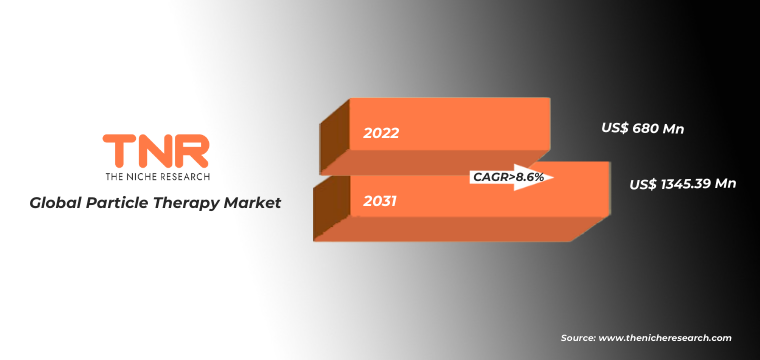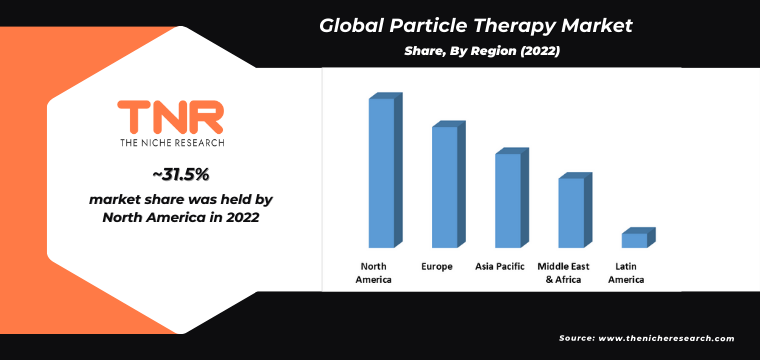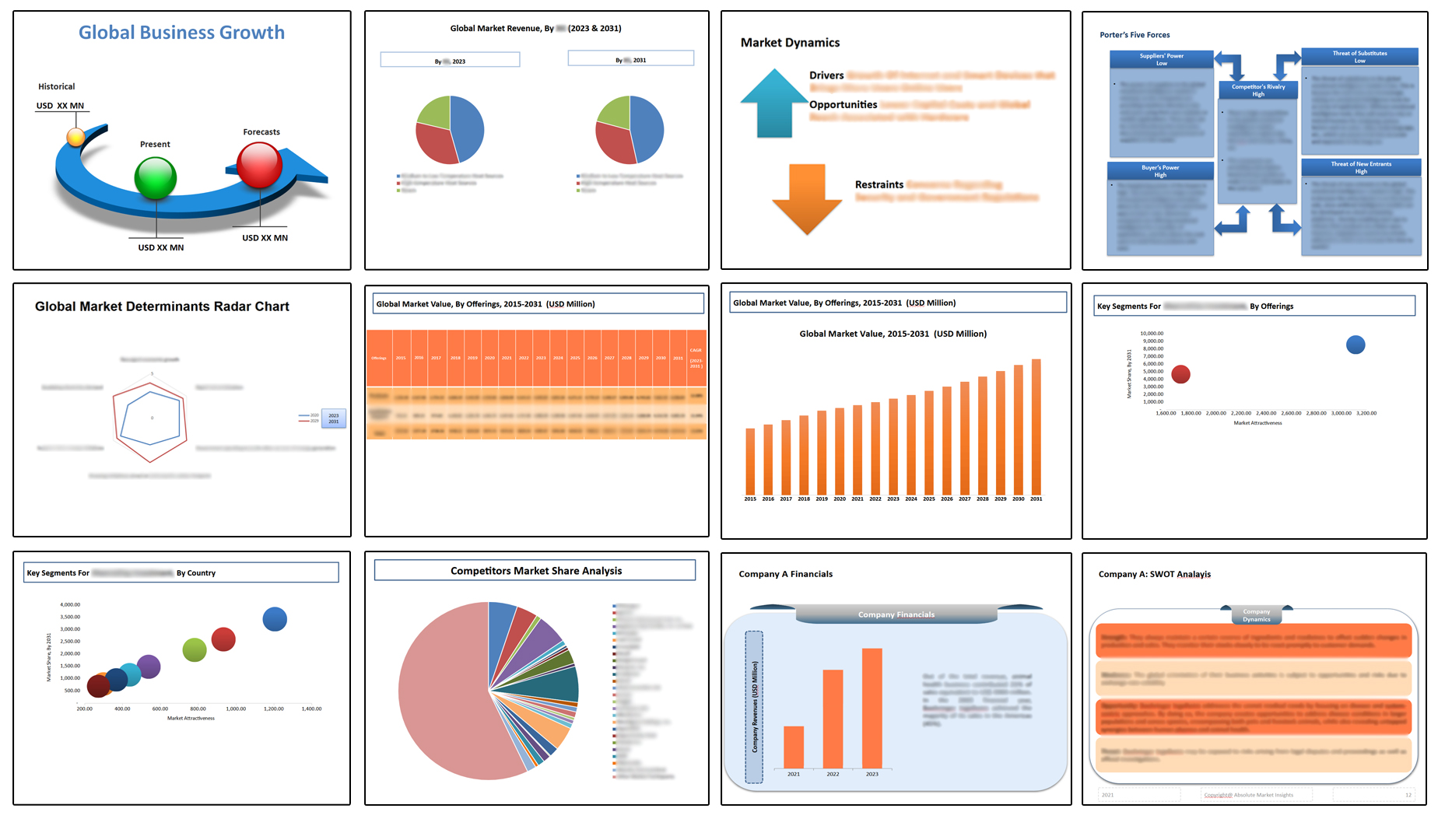Global Particle Therapy Market By Type, By Offerings, By Cancer Type, By End Users: Global Insights & Analysis Report (2015 – 2031)
- Industry: Healthcare
- Report ID: TNR-110-1020
- Number of Pages: 420
- Table/Charts : Yes
- November, 2023
- Base Year : 2024
- No. of Companies : 10+
- No. of Countries : 29
- Views : 10160
- Covid Impact Covered: Yes
- War Impact Covered: Yes
- Formats : PDF, Excel, PPT
Global Particle Therapy Market Crossed the Mark of US$ 680 Mn in 2022, Anticipated to Reach CAGR of 8.6% from 2023-2031.
Particle therapy, also known as particle beam therapy or particle radiation therapy, is an advanced form of cancer treatment that uses charged particles, such as protons or carbon ions, to irradiate and destroy cancer cells. Unlike conventional radiation therapy, which uses X-rays or photons, particle therapy harnesses the unique properties of charged particles to deliver highly targeted and precise doses of radiation to cancerous tumors.
The global particle therapy market is experiencing robust growth driven by increasing awareness of its benefits, advancements in technology, and a rising incidence of cancer worldwide. Particle therapy, including proton therapy and carbon ion therapy, has gained prominence as an effective and precise cancer treatment option with reduced side effects compared to conventional radiation therapy.
Global Particle Therapy Market Revenue & Forecast, (US$ Million), 2015 – 2031

Global Particle Therapy Market Growth Drivers
- Increasing Cancer Incidence: The rising global incidence of cancer continues to be a significant driver for the particle therapy market. In 2022, breast cancer and lung cancer stood out as the two most prevalent cancer types globally, accounting for 14.5% and 14.2% of all newly diagnosed cases. The United States reported approximately 1.9 million new cancer cases and 609,360 cancer-related deaths in the same year. As the number of cancer cases grows, there is a greater demand for advanced and precise cancer treatment options like particle therapy.
- Precision and Reduced Side Effects: Particle therapy offers superior precision in targeting cancer cells while minimizing damage to healthy tissues compared to conventional radiation therapy. This advantage drives patient demand and adoption of the particle therapy market.
- Pediatric Cancer Treatment: Particle therapy is especially valuable in treating pediatric cancers, where minimizing radiation exposure to healthy tissues is crucial. The growing awareness of this benefit has increased the use of particle therapy in pediatric oncology.
- Technological Advancements: Ongoing advancements in particle therapy technology, including improved particle accelerators and treatment planning systems, enhance treatment effectiveness and reduce costs.
- Government Support and Funding: Government support and funding for research, development, and the establishment of particle therapy centers contribute to particle therapy market growth. Public investments help expand access to particle therapy in various regions.
- Insurance Coverage: As more insurance providers cover particle therapy treatments, it becomes more accessible to a broader patient population. This financial support further drives adoption.
Global Particle Therapy Market Restraints
- High Initial Costs: Setting up a particle therapy facility requires a substantial initial investment, including the construction of specialized treatment centers and the purchase of expensive equipment. This cost can be a significant barrier for the particle therapy market.
- Limited Accessibility: Particle therapy centers are not available in all regions, leading to limited accessibility for patients. Geographic disparities in access remain a challenge.
- Reimbursement Challenges: Reimbursement policies and processes can be complex, leading to delays and uncertainties for both patients and healthcare providers. Overcoming reimbursement challenges is crucial for particle therapy market growth.
- Competition from Conventional Radiation Therapy: Conventional radiation therapy using X-rays remains the standard of care in many places due to its lower cost and wider availability. Particle therapy faces competition from established radiation treatments.
Proton therapy has gained attention and captured a significant share in the particle therapy market in 2022 for several reasons:
- Precision and Targeting: Proton therapy is highly precise in delivering radiation to tumors. It allows for better targeting of cancer cells while minimizing damage to nearby healthy tissues and organs. This precision is especially beneficial in treating pediatric cancers and tumors located near critical structures.
- Reduced Side Effects: Due to its precise targeting, proton therapy often results in fewer short-term and long-term side effects compared to traditional radiation therapy. This can lead to a better quality of life for cancer patients post-treatment.
- Clinical Efficacy: Proton therapy has demonstrated clinical efficacy in treating various types of cancers, including brain tumors, prostate cancer, head and neck cancers, and certain pediatric cancers. Its effectiveness in treating specific tumor types has contributed to its adoption.
As awareness of proton therapy has grown among patients and healthcare professionals, there has been an increasing demand for this treatment option. Patients often seek out proton therapy centers for its potential benefits, boosting its share in the particle therapy market.
Cyclotrons are an essential component of the particle therapy market accounting for ~74.8% of the total market share in 2022, particularly in the context of proton therapy. Cyclotrons are a key technology for generating the proton beams needed for proton therapy. They accelerate protons to the necessary high energies, making them suitable for precise cancer treatment. Proton therapy has gained popularity for its ability to target tumors with high precision while sparing healthy tissues.
Cyclotrons are integral to the delivery of this treatment, making them a central component in proton therapy centers. Ongoing research and development efforts have focused on improving cyclotron technology to make it more efficient, compact, and cost-effective. This has contributed to the continued adoption of proton therapy. Competition in this sector has driven innovation and influenced market dynamics. To gain a competitive edge in the particle therapy market, companies are continuously investing in research and development to improve cyclotron technology. They strive to make cyclotrons more efficient, compact, and cost-effective. This results in the development of advanced models with better performance characteristics.

For example, companies like IBA (Ion Beam Applications) and Varian (now part of Siemens Healthineers) have introduced innovative cyclotron designs for proton therapy that are more energy-efficient and compact, making them easier to install in healthcare facilities.
Competition encourages companies to diversify their product offerings to cater to different market segments. For instance, companies are developing cyclotrons with varying energy levels to meet the needs of different proton therapy applications. This diversification enables healthcare providers to choose the equipment that best fits their clinical requirements. For example, Cyclotron Radioisotope Products (CRP) offers cyclotrons with various energy levels for both research and clinical applications.
Competitive Landscape
Some of the players operating in the global particle therapy market are
- DANFYSIK A/S
- Elekta AB
- Hitachi, Ltd
- IBA SA
- Mevion Medical Systems
- Mitsubishi Electric Corporation
- P-Cure
- ProTom International
- Provision Healthcare
- Sumitomo Heavy Industries Ltd.
- Varian Medical Systems, Inc.
- Other Industry Participants
Global Particle Therapy Market Report Coverage
| Report Specifications | Details |
| Market Revenue in 2022 | US$ 680 Million |
| Market Size Forecast by 2031 | US$ 1345.39 Million |
| Growth Rate (CAGR) | 8.6% |
| Historic Data | 2015 – 2021 |
| Base Year for Estimation | 2022 |
| Forecast Period | 2023 – 2031 |
| Report Inclusions | Market Size & Estimates, Market Dynamics, Competitive Scenario, Trends, Growth Factors, Market Determinants, Key Investment Segmentation, Product/Service/Solutions Benchmarking |
| Segments Covered | By Type, By Offerings, By Cancer Type, By End Users |
| Regions Covered | North America, Europe, Asia Pacific, Middle East & Africa, Latin America |
| Countries Covered | U.S., Canada, Mexico, Rest of North America, France, The UK, Spain, Germany, Italy, Nordic Countries (Denmark, Finland, Iceland, Sweden, Norway), Benelux Union (Belgium, The Netherlands, Luxembourg), Rest of Europe, China, Japan, India, New Zealand, Australia, South Korea, Southeast Asia (Indonesia, Thailand, Malaysia, Singapore, Rest of Southeast Asia), Rest of Asia Pacific, Saudi Arabia, UAE, Egypt, Kuwait, South Africa, Rest of Middle East & Africa, Brazil, Argentina, Rest of Latin America |
| Key Players | DANFYSIK A/S, Elekta AB, Hitachi, Ltd, IBA SA, Mevion Medical Systems, Mitsubishi Electric Corporation, P-Cure, ProTom International, Provision Healthcare, Sumitomo Heavy Industries Ltd., Varian Medical Systems, Inc., Other Industry Participants |
| Customization Scope | Customization allows for the inclusion/modification of content pertaining to geographical regions, countries, and specific market segments. |
| Pricing & Procurement Options | Explore purchase options tailored to your specific research requirements |
| Contact Details | Consult With Our Expert
Japan (Toll-Free): – +81 663-386-8111 South Korea (Toll-Free): – +82-808- 703-126 Saudi Arabia (Toll-Free): – +966 800 850 1643 United States: +1 302-232-5106 United Kingdom: +447537105080 E-mail: askanexpert@thenicheresearh.com
|
Global Particle Therapy Market:
By Type
- Proton Therapy
-
- Single room
- Multi room
- Expandable rooms
- Carbon ion Therapy
-
- Fixed beam treatment room
- Rotating gantry treatment room
- Hybrid
By Offerings
- Products
-
- Cyclotron
- Synchrotons
- Services
By Cancer Type
- Brain tumors
- Spinal cord tumors
- Head and neck cancer
- Breast cancer
- Metastatic tumors
- Liver cancer
- Pancreatic cancer
- Rectal cancer
- Gynecological tumors
- Bone and Soft tissue Tumors
- Pediatric Cancer
- Intraocular tumors
- Lung Cancer
- Esophageal cancer
- Kidney cancer
- Prostate cancer
- Bladder cancer
- Others
By End Users
- Hospitals
- Cancer Treatment Centers
- Research Laboratories
- Others
By Region
- North America (U.S., Canada, Mexico, Rest of North America)
- Europe (France, The UK, Spain, Germany, Italy, Nordic Countries (Denmark, Finland, Iceland, Sweden, Norway), Benelux Union (Belgium, The Netherlands, Luxembourg), Rest of Europe
- Asia Pacific (China, Japan, India, New Zealand, Australia, South Korea, Southeast Asia (Indonesia, Thailand, Malaysia, Singapore, Rest of Southeast Asia), Rest of Asia Pacific)
- Middle East & Africa (Saudi Arabia, UAE, Egypt, Kuwait, South Africa, Rest of Middle East & Africa)
- Latin America (Brazil, Argentina, Rest of Latin America)
Report Coverage and Deliverables: LINK

Table of Contents
Note: This ToC is tentative and can be changed according to the research study conducted during the course of report completion.
**Exclusive for Multi-User and Enterprise User.
Global Particle Therapy Market Segmentation
By Type
By Offerings
By Cancer Type
By End Users
By Region
**Note: The report covers cross-segmentation analysis by region further into countries
myreport









